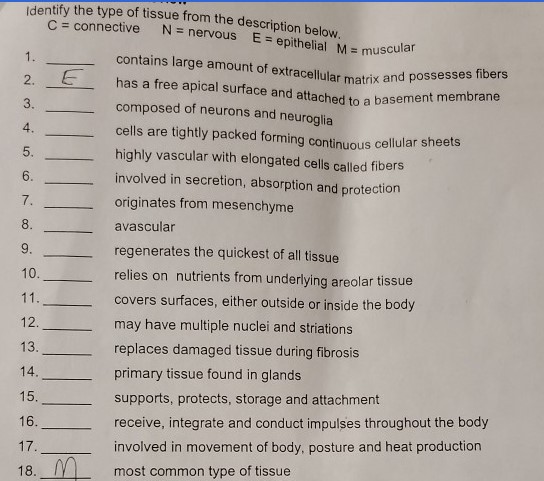QQuestionAnatomy and Physiology
QuestionAnatomy and Physiology
Identify the type of tissue from the description below C = connective N = nervous E = epithelial M=muscular contains large amount of extracellular
| 1. | Identify the type of tissue from the description below. |
| --- | --- |
| 1. | ______________ = connects N = nervous E = epithelial M = muscular |
| 2. | ______________ contains large amount of extracellular matrix and possesses fibers |
| 3. | ______________ has a free apical surface and attached to a basement membrane |
| 4. | ______________ composed of neurons and neuroglia |
| 5. | ______________ cells are tightly packed forming continuous cellular sheets |
| 6. | ______________ highly vascular with elongated cells called fibers |
| 7. | ______________ involved in secretion, absorption and protection |
| 8. | ______________ originates from mesenchyme |
| 9. | ______________ avascular |
| 10. | ______________ regenerates the quickest of all tissue |
| 11. | ______________ relies on nutrients from underlying areolar tissue |
| 12. | ______________ covers surfaces, either outside or inside the body |
| 13. | ______________ may have multiple nuclei and striations |
| 14. | ______________ replaces damaged tissue during fibrosis |
| 15. | ______________ primary tissue found in glands |
| 16. | ______________ supports, protects, storage and attachment |
| 17. | ______________ receive, integrate and conduct impulses throughout the body |
| 18. | ______________ involved in movement of body, posture and heat production |
| 19. | ______________ most common type of tissue |
Attachments

6 months agoReport content
Answer
Full Solution Locked
Sign in to view the complete step-by-step solution and unlock all study resources.
Step 1I'll solve this systematically, identifying the tissue type for each description:
Step 2: Identify the tissue type for "connects"
- Answer: $$C$$ (Connective Tissue)
- Reasoning: Connective tissue connects and supports other tissues
Final Answer
1. Connects = C 2. Large extracellular matrix = C 3. Free apical surface = E 4. Composed of neurons = N 5. Tightly packed cells = E Note: The remaining descriptions can be similarly matched to their corresponding tissue types using the same logical approach.
Need Help with Homework?
Stuck on a difficult problem? We've got you covered:
- Post your question or upload an image
- Get instant step-by-step solutions
- Learn from our AI and community of students